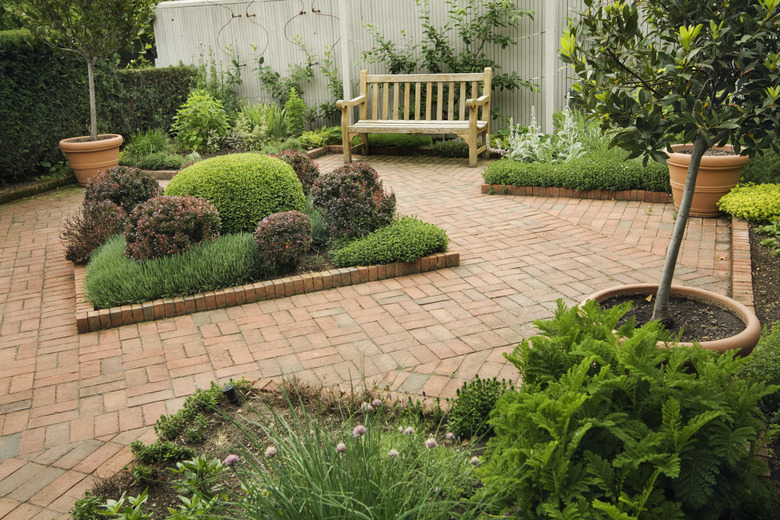How To Calculate Brick Pavers For A Patio
A paver patio creates a comfortable space to relax or socialize in your yard without damaging your grass. When building a new paver patio, though, it's important to know how many materials you need to avoid running out or wasting money on unnecessary pavers. How many pavers you need to buy varies based on the proposed layout pattern, the shape, and the size of your new patio.
Decide on Your Layout
Since some designs require more cuts to create smaller pieces and thus extra materials, you should consider your layout pattern and shape before determining how many pavers you need. A basic linear grid layout where the blocks are lined up in regular rows and columns is the easiest to lay out and takes the fewest pavers since it requires the fewest cuts to be made. For this reason, the pattern only requires you to purchase 5 to 10 percent extra materials.
On the other hand, running bond (similar to what you see in a brick wall), 90-degree herringbone (where the short edge of one brick is placed next to the long edge of the one before it), and basket weave (which features two bricks placed vertically next to two placed horizontally) each require 10 percent extra materials.
When it comes to the most material-consuming patterns, those that involve the diagonal placement of bricks and rounded shapes typically require at least 20 percent extra materials.
Find the Patio Area
When determining how many pavers you need, you need to figure out the area of your future patio. For rectangular shapes, measure the length and width and then multiply them. As an example, a 10 x 10-foot patio will be 100 square feet. To find the area of circles, you need to find the diameter of the area and then divide it by 2 to find the radius and then square that number before multiplying it by pi. For example, a circle that is 10 feet across is approximately 78.5 square feet ((10/2)² x 3.14).
For half circles, measure the radius (the distance from the center of the circle out) and then square this number, multiply it by pi, and divide it by 2 to find half of the total circle's area. So a half circle with a 5-foot radius is about 39.25 square feet ((5² x 3.14)/2). The formula for a quarter circle is the same as a half circle, only you divide the total circle area by 4 instead of 2. In other words, a quarter circle's area is about 19.6 square feet ((5² x 3.14)/4). For complex shapes, you may need to break up the space into rectangles and half or quarter circles to estimate the total area.
Estimate the Pavers Needed
To figure out how many pavers you need, find the total square inches of the pavers by measuring the length and width of a paver and then multiplying them. For example, a 12 x 12-inch paver is 144 square inches. Next, multiply the square footage of the patio space by 144 to find out how many square inches it is. For instance, a 100-square-foot patio would be 14,400 square inches (100 x 144). Then divide the patio space area by the paver area. In this case, you would need 100 pavers (14,400/144).
Multiply this minimum number of pavers by 1 plus the estimated extra you need for your layout type to ensure you have enough pavers for the job. For example, for the 100-paver patio, you need 120 pavers (100 x (1 + 0.2)) if you are doing a diagonal layout.
Use a Paver Calculator
A paver calculator can help you skip doing the math when building a rectangular patio. Just enter the size of your patio and the size of the pavers. Many calculators can even help you estimate the amount of gravel, sand base, and joint sand as well as the price of materials. When using paver calculators, remember that this is a minimum material amount, so you still need to order extra based on your layout type.
